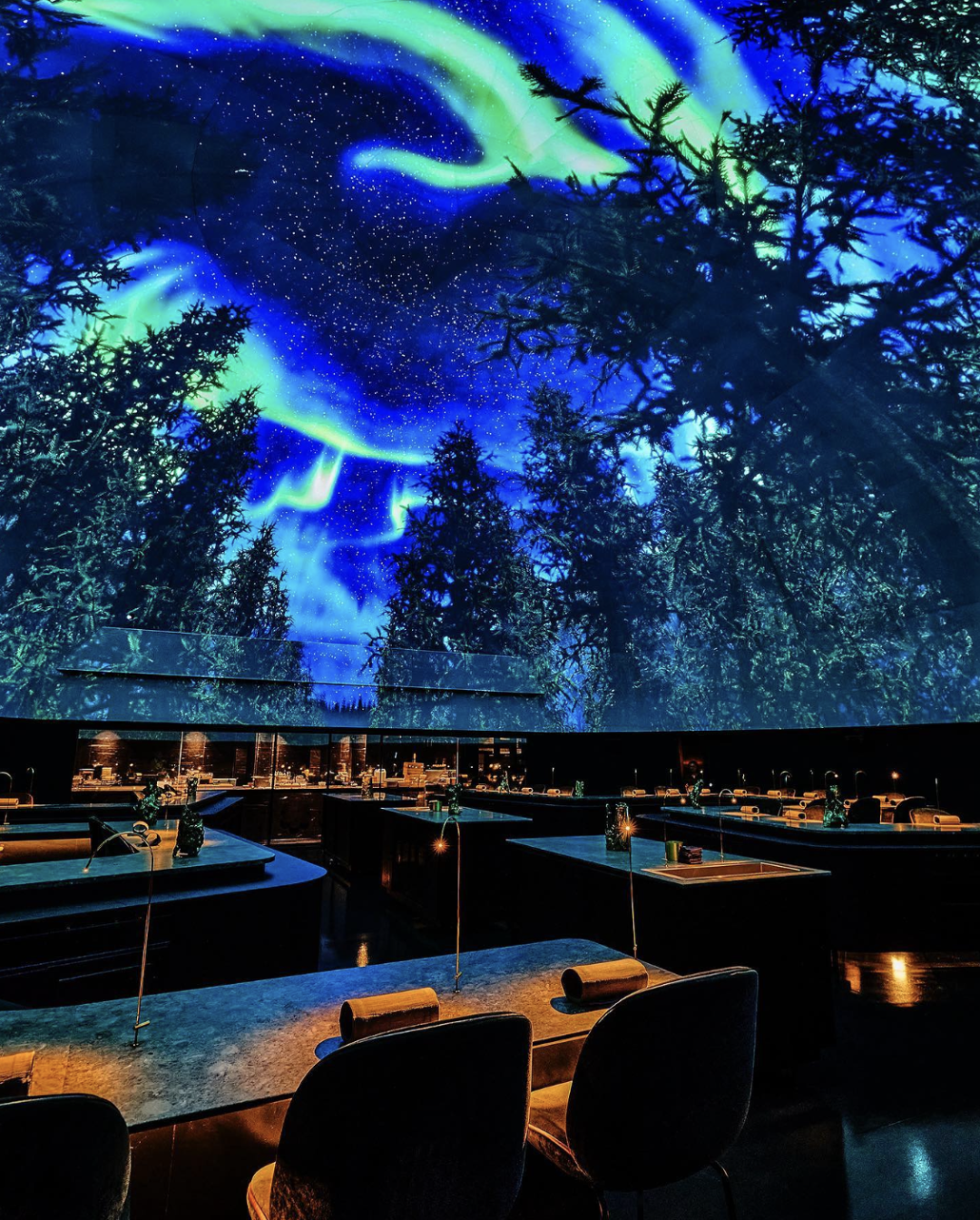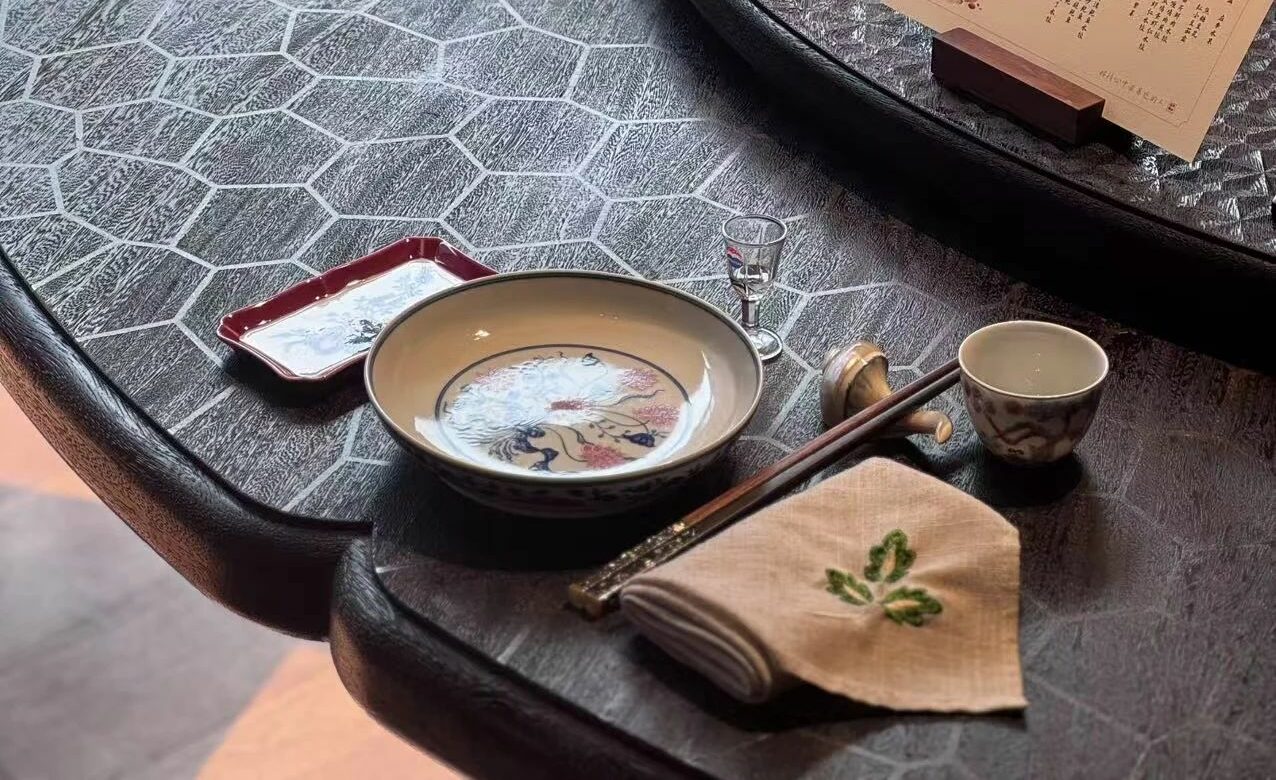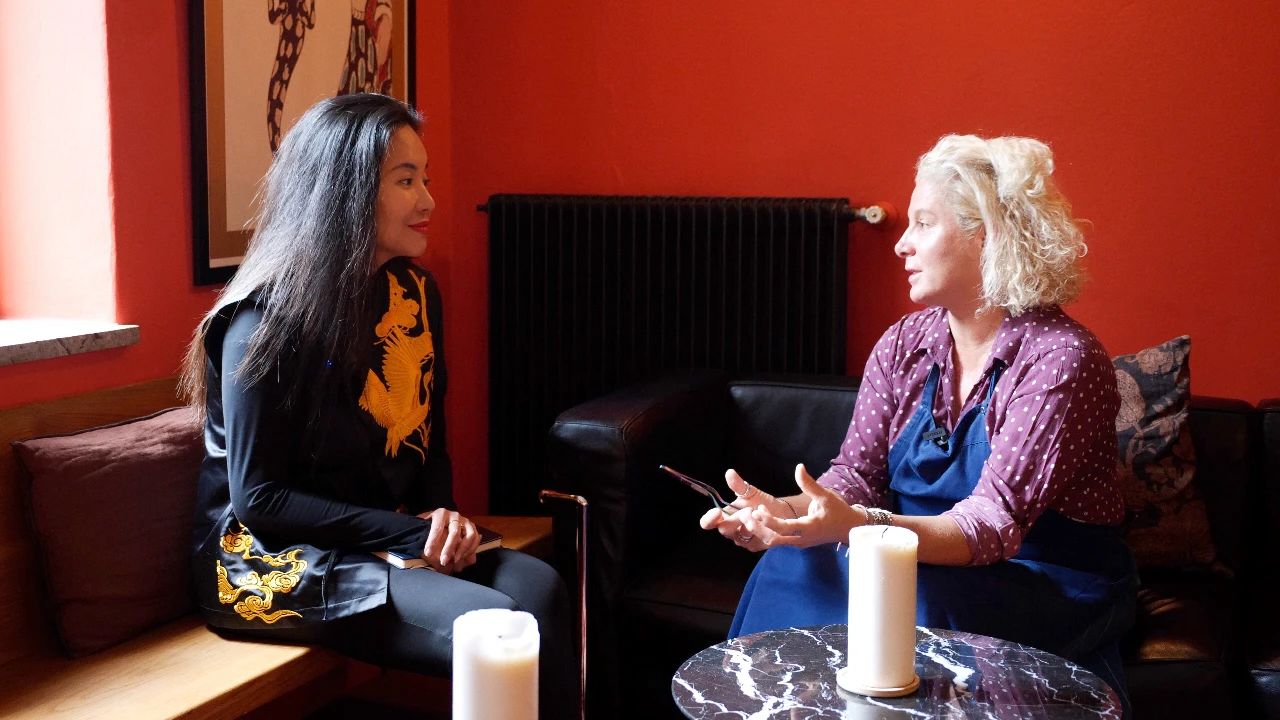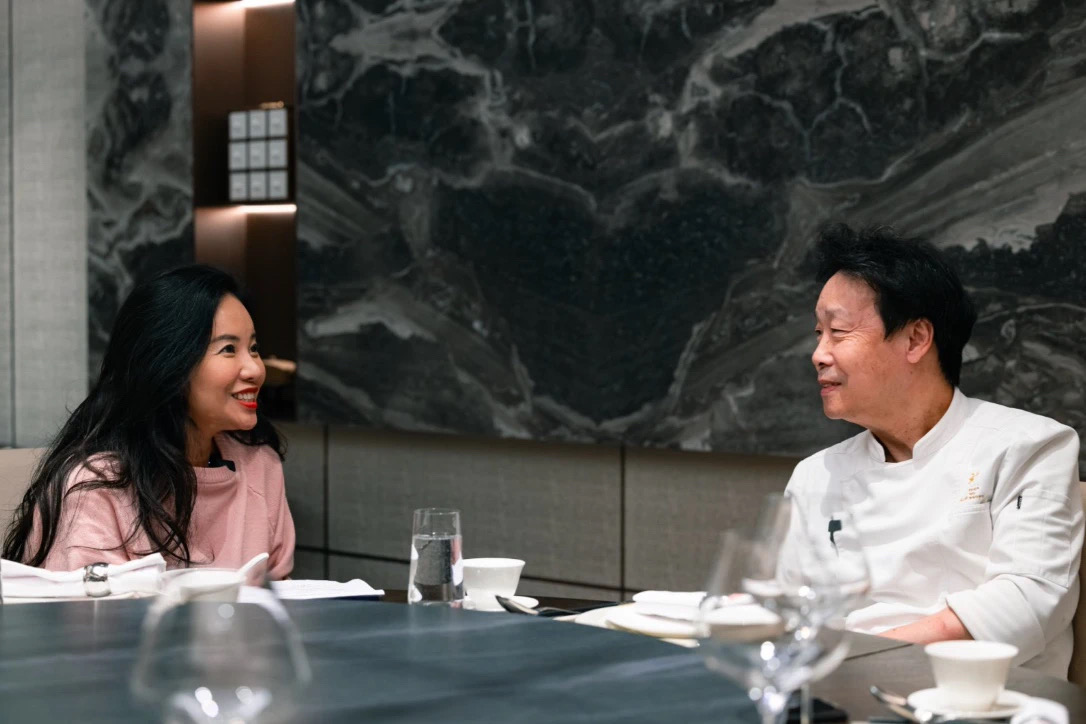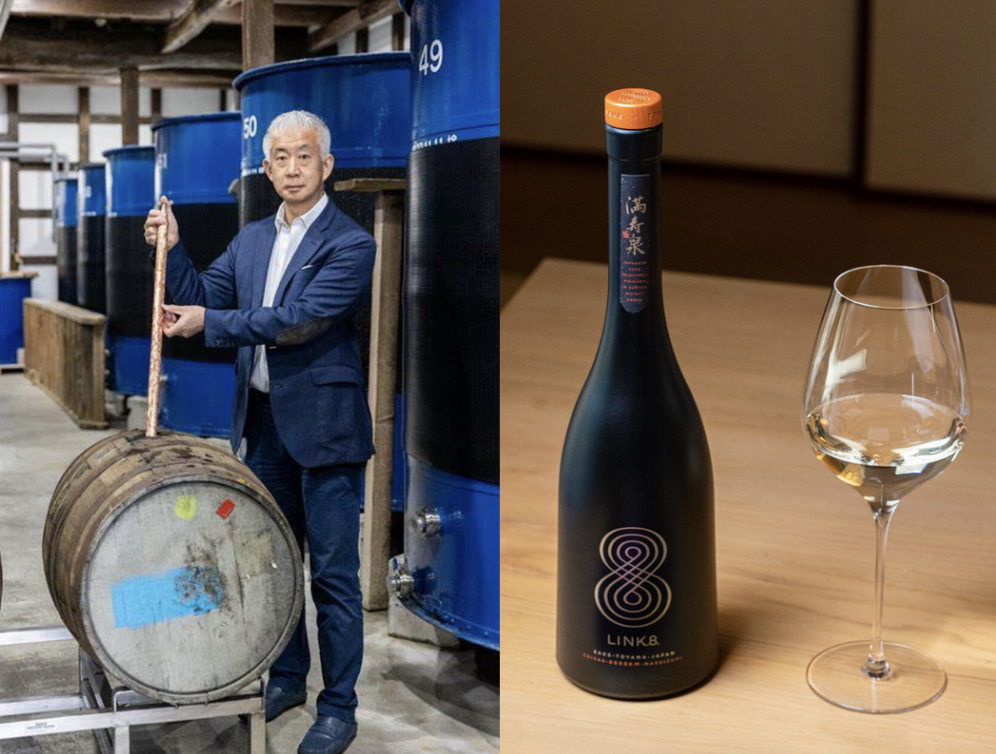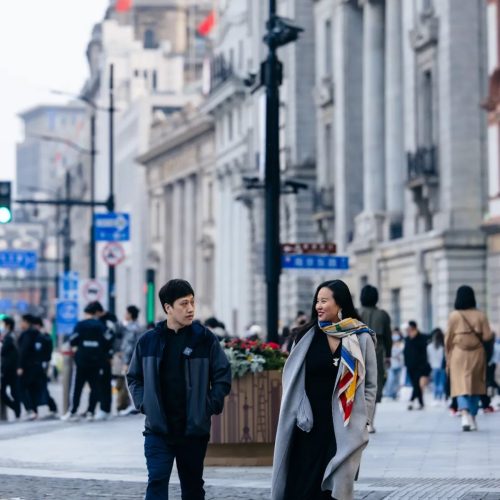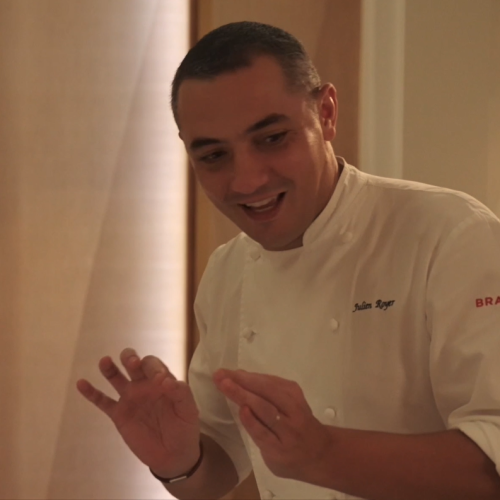Entering through a two-ton bronze door leading to a mysterious world, created by Danish artist Maria Rubinke and named “I Found Myself Within a Forest Dark,” we were greeted by enthusiastic staff. We were then led through spaces designed to evoke different emotions and thoughts, including interactive performances and visually stunning setups. The six-hour experience was both challenging and delightful, offering a once-in-a-lifetime journey through culinary and artistic wonders.
The restaurant features a glass wine cellar that allows guests to overlook the bottles beneath their feet, a dome-like planetarium with 360-degree projections blending various arts, and extraordinary culinary craftsmanship. Perhaps you already know which restaurant this is.
@Jocelyn華姐的TastyTrip YouTube
One of the hottest pieces of news in the culinary world this year is that SpaceVIP, a space travel company, announced its collaboration with Chef Rasmus Munk of Alchemist, a Michelin two-star restaurant ranked 8th in the world in 2024. They plan to offer a top-tier dinner at the edge of space, priced at $495,000, elevating cuisine to a cosmic level. Whether this will attract the attention of extraterrestrials is unknown, but at least one dish can be enjoyed right here on Earth.
This is my fourth visit to Alchemist. My first visit was in 2019 when I wrote a full-length article about the restaurant. The initial experience was overwhelming with explosive sensory and visual stimuli, leaving my mind constantly racing. Looking back at that article now, I feel a bit embarrassed. However, over the past years, these visits have shown me that Alchemist is carving out a new path, continuously evolving each year.
Alchemist is renowned for its avant-garde dining approach, and when I asked Rasmus if he agreed with this, he didn’t mind the label. They aim to explore new paths in gastronomy, combining food and experience, allowing the experience to be a framework for other elements, not just the food itself. This represents a new frontier.
Dining is all about enjoyment, but why learn so much? It’s a personal choice. For curious food enthusiasts, understanding the scenes, food and art created by the restaurant can be immensely enjoyable. More importantly, it depends on how open-minded and resilient you are.
We discussed with Chef Rasmus Munk how Alchemist combines gastronomy with theatrical art and even social activism. Chef Rasmus said, “It’s about expressing myself, having an impact, and making a change in the society we live in.” He hopes to use his culinary craft and voice to create something more meaningful and profound than just a skill. He believes that even if he weren’t a chef, he would use his medium in any creative field to discuss societal issues and actively drive change. It’s fascinating to see that restaurants and chefs can also play such roles.
 Rasmus Munk
Rasmus Munk
Food Has Its Limits, Stories Can Never Surpass Flavor or Technique
Alchemist incorporates elements of theater, art galleries, interactive performances, and dining spaces that originally existed in different dimensions. Investors need to be incredibly bold to engage in such an unprecedented project. The themes of social justice and various societal phenomena conveyed through the dishes are not meant to preach but to make diners aware of these issues. “50 Impressions” does not mean 50 dishes; Impressions represent scenes, performances, images, and dishes, each creating different memories. Every aspect, from the flavor and texture of the dishes to the visual and auditory elements of the surroundings, is meticulously designed to provide a complete sensory experience. When dining here, one does not count the number of dishes or watch the time but immerses fully in the experience. Therefore, I can only share my favorite dishes and leave the scenes to be discovered by those who have not yet visited, maintaining an element of suspense for future culinary adventurers.
The dining journey at Alchemist is divided into different scenes, each set in a unique space within the restaurant. In the beginning, during the Lounge stage, I felt many Spanish influences, as it is well known that Rasmus loves Spanish cuisine.
In fact, the food at Alchemist is absolutely delicious. The Lounge stage feels more like the perfect Tapas Bar that you could ever dream of, offering delicious food of the future. It’s hard to forget each dish in this space. Starting with Daisy: the foam on top is flavored with Colombian mandarins and lime, and underneath is a spherified Pisco Sour cocktail, a refreshing beginning to the experience. The Smokey Ball, inspired by the Indian dish Pani Puri, is made from puffed gluten with smoke trapped inside, providing a smoky aroma. It is topped with langoustine tartare, almond cream, and caviar, an irresistible combination for any palate. Paired with a sip of champagne, it brings complete satisfaction. The cotton candy dumpling casing is made from delicate Japanese wasanbon sugar, filled with a five-year fermented Nam Jim sauce and basil, offering a salty-sweet Thai flavor that is hard to resist.
 Smokey Ball
Smokey Ball
Recently, a friend wrote an article about restaurant Iris in Rosendal ,Norway , describing the collision (or intersection) of past and future food. However, at Alchemist, the future is ever-present. For example, the “Space Bread” is a freeze-dried soy meringue topped with caviar that melts in the mouth almost instantaneously, connecting to the earlier mentioned space travel cuisine. Then there is the “Butterfly,” a freeze-dried nettle butterfly placed on a crispy nettle leaf made from juiced kale, parsley, and spinach, accompanied by nettle fresh cheese. A companion mentioned that the only challenge in tasting it might be the sensation of the fuzz brushing against the tongue. These high-protein ingredients highlight the potential sources of protein in the foreseeable future of food shortages, showcasing the limitless possibilities of future cuisine.
The Perfect Omelette at Alchemist: A Yearly Favorite
One of the most beloved dishes at Alchemist, the Perfect Omelette, is enjoyed by diners each year. It features an egg yolk membrane shaped with a 3D mold, filled with egg yolk and Comté cheese cream, topped with a 0.5mm-thick slice of Joselito pork jowl, and covered with black truffle. The surface is brushed with butter infused with black pepper using ultrasound technology, giving it a high-tech yet perfect taste. Once you take a bite, you are instantly satisfied by the luxurious combination of egg yolk and pork fat melting down your throat. Rasmus mentioned, “Every year we try to improve it and make it more perfect. Although nothing in the world is perfect, it can always be slightly better.” In the latest version, they use sound waves to extract the pepper flavor and infuse it into the omelet’s skin, making it an ever-evolving dish. “Maybe one day you will publish a book titled ‘The Evolution of the Perfect Omelette’,” I suggested. “Perhaps that is possible,” he replied.
 The Perfect Omelette
The Perfect Omelette
Another appetizer, the Sunburnt Bikini, is made with cryo-fried mochi dough. When the ball rapidly rises from -60 degrees to 200 degrees, it becomes extremely crispy on the outside while remaining sweet and chewy inside. Filled with Gruyère cheese and Joselito ham, it is a texture loved by everyone. On the birthday of a 12-year-old girl named Ponyo, the restaurant specially imprinted the fried mochi ball with her favorite cartoon character. These are the touching moments that make a unique restaurant unforgettable.
Rasmus explained that their menu often addresses complex themes such as sustainability, social justice, and the future of food. These messages are integrated into the dishes without sacrificing taste. He emphasized the need for balance, with flavors, textures, and mouthfeel always taking precedence. They have created many dishes with extraordinary techniques and new aesthetics, but if the flavor is not up to par, the dish cannot be served. For him, food has its limitations; stories can never surpass flavor or technique.
Under the Dome, Nothing Is Ever “Ordinary”
Entering the Dome, some diners who have never visited Alchemist might think this is the beginning of “dark cuisine.” Each dish in this space has a unique concept, and the dome changes scenes between courses.
Though the portions are small, the variety is dazzling. One dish that left a deep impression on me was “Plastic Fantastic,” which is related to recycling. This dish uses fish skin to mimic plastic, evoking the issue of ocean pollution. In Asian cuisine, rice paper might be used for a similar effect. Here, they extract collagen from fish skin to create a plastic-like appearance and texture, making you empathize with the seafood that consumes “trash.”
When tasting this dish, the initial sensation is reminiscent of plastic. The edible plastic “vortex” is made from algae and fish skin collagen. Underneath is a tempura-battered fish with a tartar sauce made from summer pickles. The imaginative presentation, combined with a direct culinary approach, is delicious. Looking up at the dome and seeing a turtle entangled in plastic bags, you might feel a tinge of sadness, reflecting on whether you’ve contributed to environmental pollution.
Year after year, Rasmus continues to improve and enhance the presentation of dishes. For example, his “Food for Thought” dish used to be served in a movie prop-grade human brain, looking very realistic and gory. Now, he has changed the presentation to reduce discomforting elements. The dish consists of cherry meringue filled with lamb brain mousse and cherry gel, topped with freeze-dried lamb brain crisps. What Danes consider waste, we often see as everyday delicacies. Alchemist emphasizes sustainability throughout its menu, using ingredients that are typically discarded, demonstrating that even less popular parts of food can be transformed into gourmet dishes.
Discussing the Dish 1984 with Rasmus
When I spoke with Rasmus about the dish “1984,” he mentioned that his inspiration came from George Orwell’s novel “1984.” Rasmus pointed out many similarities to reality, especially with recent news related to AI. This dish is actually inspired by social media algorithms, which have not yet been adequately regulated by governments. These algorithms are designed to keep young people engaged on apps for longer periods, leading to increased activity. “If you look at the data, especially in the U.S., the impact on younger generations is quite frightening — they might end up doing nothing but sitting in front of their iPads and iPhones, which has led to a lot of depression. Everything is monitored, everything is seen, just like a surveillance society,” he said. For Rasmus, the idea of creating the “Eye” was akin to George Orwell’s Big Brother in “1984.” They replicated a human eye, with the concept being to start eating from the pupil. The pupil of the eye is filled with cream of corn, lobster tartare, pickled chanterelle mushrooms, lemon confit, and caviar.
 1984
1984
Experiencing this dark societal phenomenon while enjoying delicious food creates a striking contrast. This reminds me of the 2020 Netflix documentary “The Social Dilemma,” which premiered at the Sundance Film Festival and sparked heated discussions. “You pick a card they want you to pick.” Did you know that those who developed features for Facebook, Instagram, and Google don’t let their own kids use smartphones? We naively believe that watching certain videos or listening to certain influencers is our own choice. In fact, these choices are made by social media recommendations, and we merely accept them. This documentary, directed by Jeff Orlowski, was hailed by the Los Angeles Times as the most important documentary of 2020.
More About the Food
The dish Tongue Kiss has always frightened me. A movie prop-grade tongue is covered with garlic purée, lacto-fermented habanada pepper strips, roasted red pepper, sherry vinegar stripes, and anchovies, giving it a very Spanish flavor. Underneath the tongue, there is olive oil jam, lemon confit, and fried breadcrumbs. Is it tasty? I can only remind you to close your eyes when kissing, as the tongue feels incredibly real.
Since the release of the film “The Menu,” many restaurants have been likened to the film’s prototypes. Remember the taco dish in the movie with each guest’s crime photo on it? At Alchemist, they print images on Jerusalem artichoke cream using 3D technology. When lit from behind, different thicknesses show up as shadows, forming an image paired with artichoke slices. If you are a regular, there might be a surprise — you could end up eating a “beautiful” picture of yourself!
Another new dish is “What Came First?” The chicken head is deboned, brushed with chicken fat, roasted, and pressed into thin slices (I pondered for a long time how it was made). It is paired with classic Danish spring flavors: crème fraîche,bleak roe, and chopped chives. Tasting it feels surreal. For me, eating chicken heads is a rare opportunity, almost a childhood memory. The texture is more like fried chicken skin, but you can clearly see the entire “chicken face,” including the eyes and beak, which are edible! The taste is somewhere between salty and sweet, truly incredible!
Other Popular Dishes
Air Bread: This feather-light bread is made from potato starch sheets brushed with browned butter, roasted yeast, and onion juice. It is rolled into a croissant shape and baked in a vacuum, then topped with foam made from yeast, butter egg yolks, crème fraîche, and thin slices of vintage 2015 Joselito Pata Negra ham. It is one of the most popular dishes. Another interesting dish! Bugrata: Alchemist’s homemade burrata is made with Stracciatella cheese mixed with tomato, basil, lemon, olive oil, and mozzarella mousse, topped with salted Mirabelle plums and lardo, and finished with live, green Macrolophus pygmaeus. A delicious Italian “appetizer”? Who knows where the little bugs come from (Local or Italian ?).
 Bugrata
Bugrata
Burnout Chicken: One of Alchemist’s Signature Dishes
One of Alchemist’s signature dishes, Burnout Chicken, features a deboned chicken thigh stuffed with a soufflé of chicken and shrimp flavored with green curry spices. It is then glazed with tamarind paste and rolled in fried shrimp and puffed potatoes. The dish is presented in a cage, with the diameter proportional to the floor space available to a caged chicken, prompting diners to consider the inhumane conditions of caged chickens. The protruding chicken foot might initially seem intimidating, and the leftover foot might appear wasteful to some. This dish, with its distinct Asian flavors, is one of Alchemist’s most popular items. Rasmus explains that many people are challenged by its appearance, requiring them to take it out of the cage. However, when they taste it, they find it delicious, convincing them that it’s not as scary as it seems. “Provocation is a tool, like any other tool,” Rasmus says. “If you have a plate that lights up because it was inspired by fine art, or if you have a dish with sound, or see something on the ceiling… provocation is a tool. If used wisely, it can create awareness and long-lasting memories.” Many returning guests can recall all the dishes they had because of the related story and dramatic presentation, remembering important messages. Rasmus believes this might also be part of the discussion about “avant-garde restaurants,” and possibly a new way of restaurant expression.
Sweet Relief: The Dessert Chapter
The dessert phase at Alchemist includes a beautiful chapter called “Sweet Relief.” One dish, Reflections, features a “mirror” made of blackcurrants with vanilla ice cream underneath, accompanied by olive oil, blackcurrant gel, and chocolate crisps. Another dish, The Scream, inspired by Edvard Munch’s painting, includes saffron, Cointreau, licorice, and mandarin flavors in different textures under an edible canvas, with Munch’s artwork projected on the dome.
For the first time, I tasted “8 Layers of Life,” simulating a realistic heart that “bleeds” when cut open. This dish addresses organ donation, a topic I had never considered before. In Denmark, it’s an option for adults, while in other countries, it’s an open-ended question. This dish features eight flavors—cherry, hibiscus, black olive, deer blood, cocoa, muscovado sugar, black pepper, and lemon—echoing the fact that one organ donor can save up to eight lives. These dishes are not only visually stunning but also aim to provoke deep thought about the issues they represent.
The final dessert, Guilty Pleasure, is packaged in a disguised commercial chocolate wrapper. Inside is a chocolate bar made from 70% Congo chocolate, filled with mango jam, roasted peanut gianduja, salted caramel, and crispy cacao—a sinful combination justifying its name.
Alchemist’s Menu: Creativity and Conceptual Dishes
The menu at Alchemist showcases the restaurant’s creativity and conceptual dishes, each carrying profound meaning and stunning presentation. From Plastic Fantastic to8 layers of life, each dish is not only delicious but also an experience and reflection.
I asked Chef Rasmus how he sees the future of fine dining and the Alchemist’s role in it. He believes fine dining will always be relevant because it represents industry innovation and creativity. He thinks future guests will demand more, seeking experiences beyond just good food. Storytelling and experience will become very important, which is what they strive for at Alchemist. He sees experience-driven restaurants becoming a part of fine dining, and possibly the main form of fine dining in the future.
 The Author (Left) and Chef Rasmus Munk (Right)
The Author (Left) and Chef Rasmus Munk (Right)
The Balcony and Petit Four
The best way to enjoy Alchemist is to ensure a good night’s sleep the night before, have a coffee in the morning, eat an open sandwich for lunch, take a good walk after the meal, and perhaps a nap. Then, you can fully enjoy an entire evening in an alternate world.
Rasmus Munk is a fascinating person, seemingly with an old soul and immense talent, despite his youth. He is very personable, making conversations with him a delightful experience. The dining space created by Alchemist, hovering between dream and reality, is beyond imagination. You can define it yourself, and the experience is highly personal—a true miracle.


